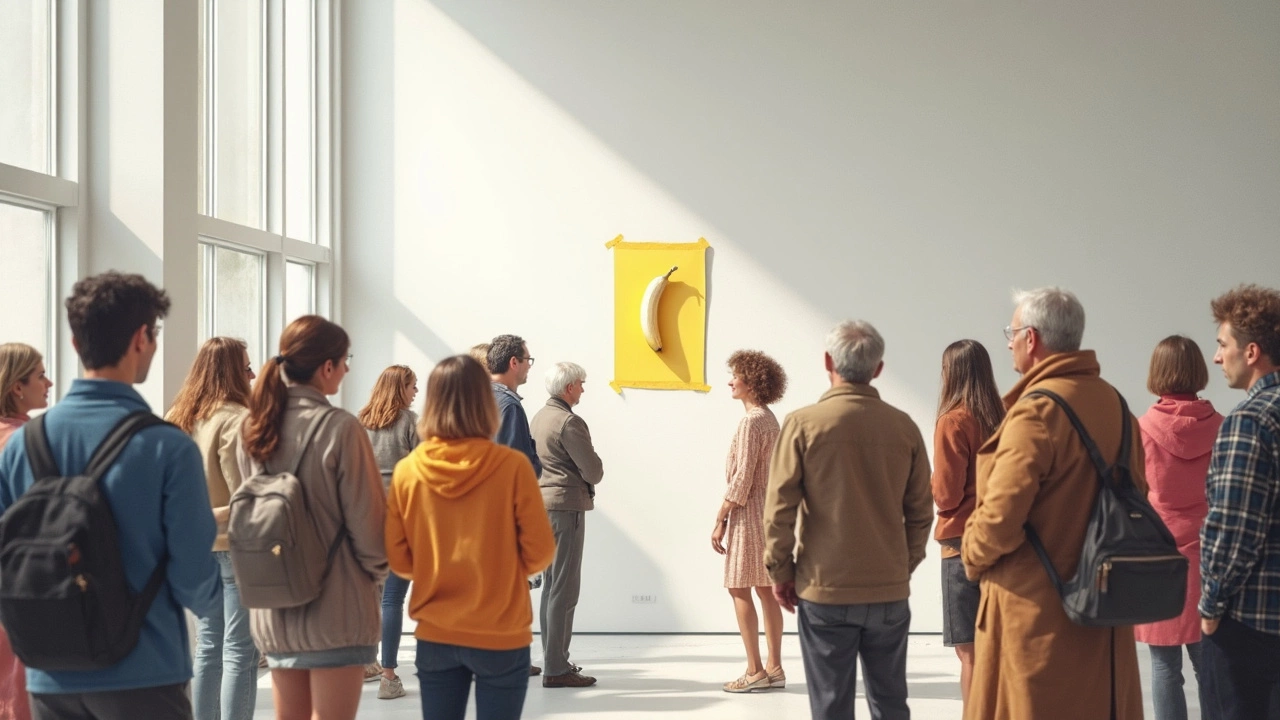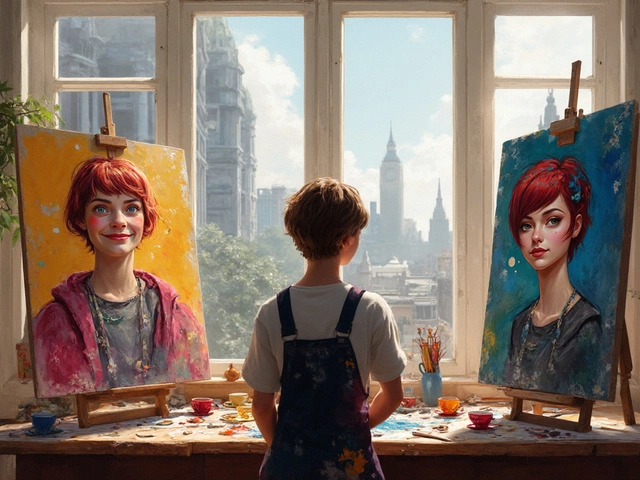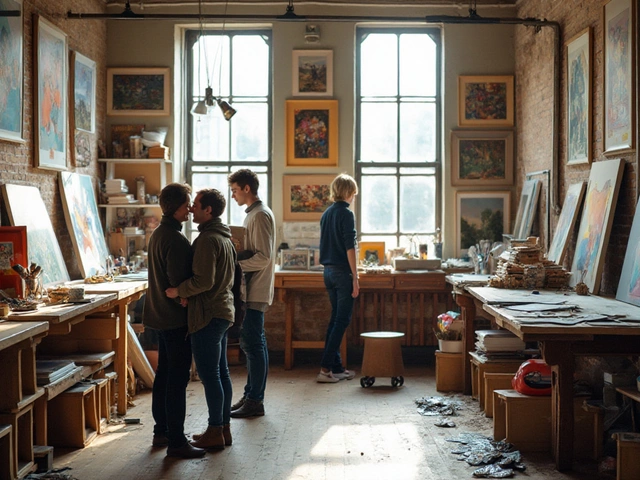Ever stared at a splash of paint or a pile of random objects in a gallery and wondered if someone’s pulling your leg? You’re not alone. That gut reaction—disbelief, confusion, maybe even frustration—happens to a lot of people when they walk into the world of modern art. Sometimes it feels like you’re missing a secret handshake or the rules to a private club.
It actually makes sense, though. We all grow up with a certain idea of what art should look like: realistic portraits, beautiful landscapes, stuff that clearly took skill. But the modern art world loves to challenge that, sometimes a little too hard for comfort. Suddenly, you’re faced with giant color blocks or a urinal on a pedestal, and the old ways of 'getting' art just don’t work anymore.
Instead of pretending to understand or writing it off as nonsense, why not dig into why these reactions happen? There’s more to this than snobbery or a lack of 'taste.' Plus, a few mindset shifts and practical tricks can actually turn those confusing moments into something a lot more fun—or at least less annoying.
- Expectations vs. Reality: Art Isn’t Always What You Think
- The 'Anyone Could Do That' Problem
- The Role of Context: It’s Not Just About What’s on the Wall
- How to Give Modern Art an Honest Shot
Expectations vs. Reality: Art Isn’t Always What You Think
Most folks walk into an art museum expecting to see paintings or sculptures that look like something familiar—maybe faces, towns, or landscapes. But step into a modern art exhibit, and you might find a giant metal spoon sticking out of grass or a plain black square. It catches you off guard, and that’s exactly the point. Modern art isn’t about copying reality. Artists started to shift away from that in the late 1800s. Think about Picasso breaking up faces into wild shapes or Jackson Pollock flinging paint onto the canvas without a brush. They ditched old traditions on purpose, trying to shake things up and make people see the world differently.
This big switch in art didn’t happen overnight. Fact: When Claude Monet showed his painting “Impression, Sunrise” in 1874, critics made fun of it. They said it looked unfinished or messy, but that style became the start of modern art. People weren’t ready for it. Even now, a lot of us expect ‘good’ art to be neat, realistic, and easy to understand—basically, something our grandma would hang over the couch. When art doesn’t check those boxes, it leaves us feeling lost or a bit annoyed.
Here’s how expectations usually clash with reality in a modern art gallery:
- The subject is too abstract. You can’t figure out what it’s supposed to be about.
- It looks like something a kid could make. People feel like skill is missing.
- The price versus appearance throws people off. Why does a plain canvas cost more than a car?
This isn’t just a feeling. Museum surveys show nearly half of first-time visitors to modern galleries report being “confused” or “underwhelmed” by what they see.
| Year | Type of Art | Visitor Satisfaction (%) |
|---|---|---|
| 2022 | Traditional Art | 78% |
| 2022 | Modern Art | 55% |
But here’s the trick: modern artists aren’t trying to fool people, they’re offering new ways to react, think, or even laugh. It really helps if you go in expecting a surprise instead of searching for a “right” answer on the wall. Turns out, having less-clear rules is what drives both the confusion and the change.
The 'Anyone Could Do That' Problem
If you’ve ever stood in front of a modern painting and thought, “My kid could have done that,” you’re hitting one of the most common roadblocks for people who don’t like modern art. This idea pops up everywhere, especially when looking at stuff like Jackson Pollock’s paint splatters or Mark Rothko’s massive color rectangles. People see simple shapes or messy lines and wonder what’s so special. Where’s the talent? The hard work?
Let’s break it down. Back when art meant showing off realistic detail, paintings took weeks or even months to finish. Masters like Leonardo da Vinci or Johannes Vermeer were basically flexing their technical skills. But starting in the early 1900s, artists decided to shake things up. They started to care less about looking real and more about ideas, emotions, and new ways to see the world. Modern art is often about making you think, not just say, “Wow, that looks real.”
Here’s the twist: a lot of so-called “simple” art took serious thought. Take Kazimir Malevich’s “Black Square” from 1915. People joked that anyone could paint a black square, but it was a radical statement against tradition at the time. Same goes for Marcel Duchamp sticking a urinal in a gallery—he called it art, and suddenly everyone had to rethink what the word even meant.
But the stats don’t lie: a 2019 survey by the YouGov group showed that 44% of people in the US agree with the statement, “Modern art is something anyone could do.” Only about 22% say they actually enjoy viewing it, showing that this attitude is hardly rare.
| Survey Response | Percent |
|---|---|
| "Anyone could do this" | 44% |
| Enjoy modern art | 22% |
So, why do the ‘simple’ works still get museum space or sell for insane amounts? A big reason is that the idea or context behind the art matters as much as the visuals. Experts say what separates 'art' from a random sketch is what the work says about the world, who made it, and why it exists at all. In other words, yeah, someone might copy the look, but they can’t copy the moment or the message that made it famous in the first place.
If you find yourself saying, “I don’t get it,” you’re not being rude—you’re actually noticing a big part of what makes modern art tricky. The trick is to stop looking for technical magic and start asking, “What’s the bigger point?” Sometimes, the story matters much more than the brushwork.

The Role of Context: It’s Not Just About What’s on the Wall
So you’re staring at a modern art piece—a red square on a white canvas, maybe. Most people just see paint. But here’s the trick a lot of newcomers miss: context is everything in modern art. A painting or sculpture can seem boring or pointless until you know who made it, why they made it, or when it was made. Seriously, sometimes half the meaning is in the backstory.
Take Marcel Duchamp’s “Fountain” from 1917. It’s literally a urinal. Alone, it just looks like something from a hardware store. But when you find out it was him challenging what counts as art, flipping the bird to traditional art critics, it suddenly becomes a cheeky statement. Or consider Mark Rothko’s color fields. On Instagram, they might seem bland, but knowing he wanted people to stand close and feel emotions changes the game.
Where you see art also matters. Museums fill you in with wall text, tours, or audio guides. In 2015, the Tate Modern found that visitors understood abstract pieces way better when they had quick context cards—people went from saying "I don’t get it" to "Okay, that’s actually cool." Context bridges the gap between the artist and you, making weird stuff actually relatable.
- Read the description by the artwork. Even two sentences can flip your opinion.
- Look up the artist. Their story or beliefs often spill into their work.
- Think about the social or historical time. Was it made during a war, a protest, a tech revolution? Context adds layers.
- Ask guides or staff for shortcuts. A quick tip from someone who works there can make everything click.
Check out this bit of data from a MoMA visitor study:
| Visitor Group | Understood Piece (w/o Context) | Understood Piece (with Context) |
|---|---|---|
| First-timers | 21% | 62% |
| Regulars | 47% | 78% |
So, don’t think you have to "get it" right away. If you learn a bit about what’s behind the frame or sculpture, you’ll enjoy it more—or at least see where the artist was coming from, even if it's still not your thing.
How to Give Modern Art an Honest Shot
Walking into a modern art exhibit with zero background can be disorienting. But here’s what most regular folks don’t realize: you’re not supposed to get everything right away. Even seasoned art critics get stumped sometimes. The trick is to give it a fair chance instead of shutting down at the first weird canvas.
Start by dropping the pressure to figure out a 'hidden meaning.' Sometimes, the artist isn’t trying to communicate a deep secret. Did you know that Jackson Pollock’s drip paintings were criticized as childish? Now they sell for $200 million. The idea isn’t always about beauty or skill, but about feeling something different, or just getting you to pause and think.
If you want to actually enjoy—or at least understand—modern art, here are some practical steps:
- Go at Your Own Pace: There’s no rule saying you must look at every piece in detail. If something grabs you, stop. If not, move on until something does.
- Ask Questions Out Loud: Even a simple “What’s going on here?” can lead to noticing details you’d miss at first glance. Kids are great at this—copy them.
- Read the Placards: These little signs often tell you what was happening in the world when the art was made, or what the artist was thinking. Suddenly, a plain black square gets a backstory.
- Compare Notes: Visit with a friend and talk about your reactions. Sometimes, the best insights come from what annoys or amuses you both.
- Look for Patterns: Artists from certain periods or groups often use similar styles or colors. Spotting a trend even in things you don’t like sharpens your eye.
Here’s a quick breakdown of numbers when it comes to reactions in a modern art gallery:
| Reaction | Approx. Visitors (%) |
|---|---|
| Curious/Interested | 44 |
| Confused | 32 |
| Bored/Annoyed | 18 |
| Inspired | 6 |
If you hit that confused or annoyed zone, you’re in good company. This is actually a normal reaction—most people in a modern art museum aren’t having huge epiphanies every time they walk in. If you walk out with even one piece making you think or smile, that’s a win.
One last thing: If you still hate modern art after giving it a shot, that’s fine. Not every style is for everyone. But next time you see a banana taped to a wall—or a mess of colored stripes—you’ll know some folks see something else entirely, and that’s part of what keeps the world (and museums) interesting.





